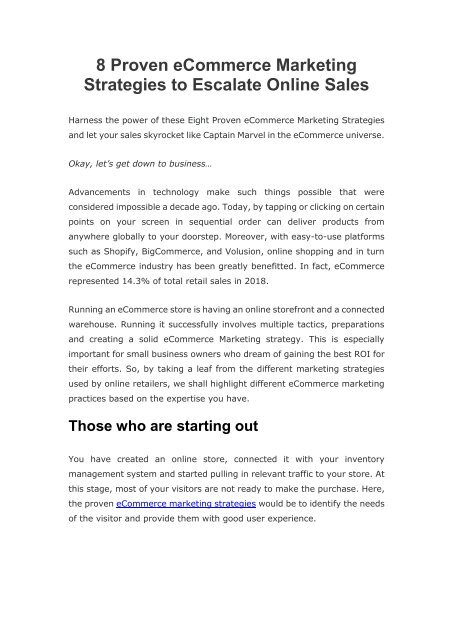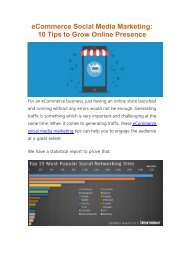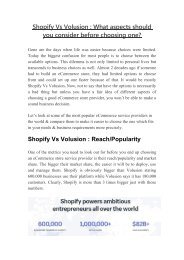8 Proven eCommerce Marketing Strategies to Escalate Online Sales
8 proven eCommerce marketing strategies to run a successful online store and to convert visitors to customers.
8 proven eCommerce marketing strategies to run a successful online store and to convert visitors to customers.
Create successful ePaper yourself
Turn your PDF publications into a flip-book with our unique Google optimized e-Paper software.
8 <strong>Proven</strong> <strong>eCommerce</strong> <strong>Marketing</strong><br />
<strong>Strategies</strong> <strong>to</strong> <strong>Escalate</strong> <strong>Online</strong> <strong>Sales</strong><br />
Harness the power of these Eight <strong>Proven</strong> <strong>eCommerce</strong> <strong>Marketing</strong> <strong>Strategies</strong><br />
and let your sales skyrocket like Captain Marvel in the <strong>eCommerce</strong> universe.<br />
Okay, let’s get down <strong>to</strong> business…<br />
Advancements in technology make such things possible that were<br />
considered impossible a decade ago. Today, by tapping or clicking on certain<br />
points on your screen in sequential order can deliver products from<br />
anywhere globally <strong>to</strong> your doorstep. Moreover, with easy-<strong>to</strong>-use platforms<br />
such as Shopify, BigCommerce, and Volusion, online shopping and in turn<br />
the <strong>eCommerce</strong> industry has been greatly benefitted. In fact, <strong>eCommerce</strong><br />
represented 14.3% of <strong>to</strong>tal retail sales in 2018.<br />
Running an <strong>eCommerce</strong> s<strong>to</strong>re is having an online s<strong>to</strong>refront and a connected<br />
warehouse. Running it successfully involves multiple tactics, preparations<br />
and creating a solid <strong>eCommerce</strong> <strong>Marketing</strong> strategy. This is especially<br />
important for small business owners who dream of gaining the best ROI for<br />
their efforts. So, by taking a leaf from the different marketing strategies<br />
used by online retailers, we shall highlight different <strong>eCommerce</strong> marketing<br />
practices based on the expertise you have.<br />
Those who are starting out<br />
You have created an online s<strong>to</strong>re, connected it with your inven<strong>to</strong>ry<br />
management system and started pulling in relevant traffic <strong>to</strong> your s<strong>to</strong>re. At<br />
this stage, most of your visi<strong>to</strong>rs are not ready <strong>to</strong> make the purchase. Here,<br />
the proven <strong>eCommerce</strong> marketing strategies would be <strong>to</strong> identify the needs<br />
of the visi<strong>to</strong>r and provide them with good user experience.
1. List out your cus<strong>to</strong>mer journey<br />
Not everyone that visits your s<strong>to</strong>refront is going <strong>to</strong> be turning in<strong>to</strong> cus<strong>to</strong>mers,<br />
at least not in the first few visits. They need <strong>to</strong> be gradually imparted<br />
knowledge about your brand, products, services, how they shall be<br />
benefited, etc at different stages before they can be capable <strong>to</strong> make a<br />
purchase. While the cus<strong>to</strong>mer journey for every business starts with a<br />
prospect and completes at cus<strong>to</strong>mers, the intermediate stage might vary.<br />
So it is very important <strong>to</strong> chart out the cus<strong>to</strong>mer journey and define<br />
miles<strong>to</strong>nes that indicate the promotion <strong>to</strong> a different stage.<br />
A standard cus<strong>to</strong>mer journey with different stages are:<br />
Prospects → Leads or <strong>Marketing</strong> Qualified Leads → <strong>Sales</strong> Qualified<br />
Leads → Low-Value Cus<strong>to</strong>mer → Loyal Cus<strong>to</strong>mer → High-Value<br />
Cus<strong>to</strong>mer<br />
2. Create a content marketing plan<br />
After you have devised the different stages of the cus<strong>to</strong>mer journey, next<br />
comes the points of contact where you can reach out <strong>to</strong> your prospects.<br />
Even though no one is going <strong>to</strong> make a purchase based on what they read in<br />
a blog post, the blog post or any other form of content can at least influence<br />
the decision in your favor. Create a content marketing plan helps you<br />
identify which form of the content does your prospect consume more. It<br />
could be a blog post, infographic, flash card, case studies, eBook, style guide,<br />
or even a checklist.<br />
Your content can revolve around the advantages of using your products,<br />
how <strong>to</strong> use your services or how people have been benefited with your<br />
services. Such content acts as the trust-building activity for pursuing<br />
prospects as well as bringing over those who are still on the fence.<br />
3. Set up an email marketing au<strong>to</strong>mation
Assuming that you have created your content marketing plan, now it is time<br />
<strong>to</strong> ensure that your content reaches the target audience. Emails are a great<br />
way <strong>to</strong> achieve this as they are easy <strong>to</strong> use, has very high investment v/s<br />
ROI ratio, will remain in the inbox of your subscribers unless purged.<br />
Additionally, in inbound methodology, emails are a vital part in 3 out of the<br />
4 stages namely Convert, Close and Delight.<br />
Moreover, thanks <strong>to</strong> USPs such as au<strong>to</strong>mation and personalized tags, emails<br />
are a great way <strong>to</strong> ensure that your cus<strong>to</strong>mers receive personalized emails<br />
based on their online behavior without you having <strong>to</strong> manually moni<strong>to</strong>r each<br />
email. Setting up an email marketing au<strong>to</strong>mation doesn’t involve you<br />
jumping through hoops; all you need is an email service provider<br />
(MailChimp, Hubspot, Aweber, etc) a client relationship management<br />
software (Zoho, <strong>Sales</strong>force, Microsoft Dynamics, etc) and the integration of<br />
both with your s<strong>to</strong>refront.<br />
4. Invest in a good recommendation engine<br />
It feels good when you have someone <strong>to</strong> suggest you similar products based<br />
on your choices. A recommendation engine is a bridge between your<br />
knowledge of your products and what your cus<strong>to</strong>mers are looking for. The<br />
recommendation engine moni<strong>to</strong>rs the products your prospects browse<br />
and/or purchase and scours through your product list <strong>to</strong> find similar or<br />
relevant products <strong>to</strong> be recommended. This opens up opportunities <strong>to</strong> upsell<br />
better products or cross-sell relevant products.<br />
Those who are comfortable with their<br />
business<br />
You have managed <strong>to</strong> bring in a steady flow of s<strong>to</strong>re visi<strong>to</strong>rs and<br />
successfully managed <strong>to</strong> bring sales but you are aiming for growth.<br />
The following <strong>eCommerce</strong> marketing strategies are <strong>to</strong> increase the<br />
number of visi<strong>to</strong>rs, increasing engagement with existing cus<strong>to</strong>mers<br />
and reduce the number of abandonment (both cart as well as the<br />
browser).
5. Conduct Sweepstakes or Giveaways <strong>to</strong><br />
increase engagement<br />
Imagine getting a chance <strong>to</strong> grab the thing that you are planning <strong>to</strong><br />
buy, for a discounted price or free. Would you let such an<br />
opportunity <strong>to</strong> go <strong>to</strong> waste? Similar is for your cus<strong>to</strong>mers. When<br />
you offer exclusivity or discount in the form of sweepstakes or a<br />
giveaway, those on the fence <strong>to</strong> make the purchase would take the<br />
bait. Sweepstakes draws in new visi<strong>to</strong>rs <strong>to</strong> your website and most<br />
of such visi<strong>to</strong>r would explore the rest of the website after taking<br />
part. By experimenting with different kinds of offers, sweepstakes<br />
and giveaway <strong>to</strong>ols can help you identify what moves your<br />
cus<strong>to</strong>mer base better.<br />
6. Have a Loyalty reward program<br />
The success of a business depends on repeat orders and loyal<br />
cus<strong>to</strong>mers. Just as sweepstakes are a great way <strong>to</strong> draw in the new<br />
audience, a loyalty reward program holds your cus<strong>to</strong>mer base<br />
<strong>to</strong>gether. Your products/services may be greatly helpful <strong>to</strong> the<br />
end-cus<strong>to</strong>mer but when you include additional rewards on every<br />
purchase, you encourage them <strong>to</strong> return <strong>to</strong> your s<strong>to</strong>re every time<br />
they plan <strong>to</strong> make a purchase. Even though what matters at the<br />
end of the day is a good user experience but a loyalty reward<br />
program provides an incentive for your cus<strong>to</strong>mers <strong>to</strong> remain loyal<br />
<strong>to</strong> your brand even in the presence of competition.<br />
7. Invest in a display ad program<br />
Ad monetization is a boon for marketing realm. It brings revenue<br />
for website owners and visibility for brands who enroll in the<br />
display ad program. Display ad marketing is a great way <strong>to</strong> bring<br />
your brand in front of those who satisfy particular traits. How<br />
the display advertisement works is using cookies. These cookies<br />
are a unique identifier for different devices helps track the owner’s
online behavior. <strong>Online</strong> advertising platform such as Google<br />
Adwords and Bing Ads! display your ads <strong>to</strong> those individuals whose<br />
online behavior matches your cus<strong>to</strong>mer persona based on the<br />
s<strong>to</strong>red cookie data in their devices. Display advertising has two<br />
major benefits:<br />
1. It can be used for acquiring new leads, contextual marketing,<br />
and re-targeting abandoners as well as dormant cus<strong>to</strong>mers<br />
2. Most social media platforms support display advertisements so<br />
greater visibility compared <strong>to</strong> other marketing channels<br />
8. SEO and SEM<br />
As per Retailing Today, 81% of shoppers report conducting online<br />
research prior <strong>to</strong> making a large purchase. If you fail <strong>to</strong> be present<br />
on the first page of their search, you might have lost a prospective<br />
cus<strong>to</strong>mer. You may have the best products and your s<strong>to</strong>re may be<br />
the one your cus<strong>to</strong>mers are looking for, but it is meaningless unless<br />
visible on a search engine result. By adding relevant keywords <strong>to</strong><br />
specific pages and have a good SEO score, the search engine<br />
determines that your s<strong>to</strong>re might be the best suit for someone’s<br />
search query and you get a visi<strong>to</strong>r.<br />
Unfortunately, in this age of competition, relying on ranking on<br />
specific keywords is not going <strong>to</strong> bring in visi<strong>to</strong>rs. search engine<br />
marketing wherein you bid on certain keywords and based on the<br />
bid amount, your result is shown as an ad.





